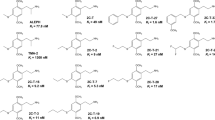Abstract
The head shake reflex is a rapid rhythmic shaking of the head in a radial motion and is a prominent part of the behavior of most mammalian species. The administration of agonists at 5-hydroxytryptamine (5-HT) receptors to rats increases apparently-spontaneous head shaking behavior. The present study examined the relationship between the head shake reflex, elicited by stimulation of the aural ampullae with Tween 80, with a similar-appearing behavior, the head shake response caused by the administration of 5-HT agonists to rats. Head shaking was attenuated by the subcutaneous infiltration of the local anesthetic procaine into the posterior border of the external auditory meatus. However, the local anesthetic did not alter head shake behavior produced by administering either the 5-HT agonist quipazine or the 5-HT precursor 5-hydroxy-L-tryptophan (l-5-HTP). The magnitude of the head shake reflex was also diminished after habituation of the reflex by repeatedly applying Tween 80 to the ampullae, yet this treatment had no effect on the head shaking behavior caused by quipazine. In a complementary manner, pretreatment with the 5-HT2 receptor antagonist ketanserin potently blocked shaking behavior caused by quipazine without significantly altering the head shake reflex. Chronic administration of the atypical antidepressant drug iprindole to rats for 7 days reduced quipazine-induced shaking behavior without affecting the head shake reflex. In contrast, chronic administration of the monoamine oxidase inhibitor phenelzine to rats for 7 days reduced head shaking behavior caused by either stimulus, indicating that an attenuation of motor reflex activity could play a role in the reduced response to quipazine. When shaking behavior caused by the auricular application of Tween 80 was combined simultaneously with quipazine, these two treatments produced additive effects on shaking behavior. No support was found in these experiments using rats that head shaking behavior caused by 5-HT agonists involved the enhanced perception of normally-subliminal cutaneous stimuli from the pinna region that usually elicit the head shake reflex. Instead, 5-HT agonists and aural pinna stimulation appeared to produce head shaking behavior in rats by independent physiological mechanisms. However, these mechanisms may intersect insofar as the motor pathways of the head shake reflex may be common with the motor pathway for eliciting shaking behavior by the stimulation of central 5-HT receptors.
Similar content being viewed by others
References
Askew HR (1970) Effects of stimulus intensity and intertrial interval on habituation of the headshake response in the rat. J Comp Physiol Psychol 72:492–497
Bedard P, Pycock CJ (1977) “Wet-dog” shake behaviour in the rat: a possible quantitative model of central 5-hydroxytryptamine activity. Neuropharmacology 16:663–670
Boulton CS, Handley SL (1973) Factors modifying the head twitch response to 5-hydroxytryptophan. Psychopharmacologia 31:205–214
Corne SJ, Pickering RW, Warner BT (1963) A method for assessing the effects of drugs on the central actions of 5-hydroxytryptamine. Br J Pharmacol 20:106–120
Drust EG, Connor JD (1983) Pharmacological analysis of shaking behavior induced by enkephalins, thyrotropin-releasing hormone or serotonin in rats: Evidence for different mechanisms. J Pharmacol Exp Ther 224:148–154
Friauf E, Herbert H (1985) Topographic organization of facial motoneurons to individual pinna muscles in rat (Rattus rattus) and bat (Rousettus aegyptiacus). J Comp Neurol 240:161–170
Leysen JE, Awouters F, Kennis L, Laduron PM, Vandenberk J, Janssen PAJ (1981) Receptor binding profile of R 41 468, a novel antagonist of 5-HT2 receptors. Life Sci 28:1015–1022
Lucki I, Frazer A (1985) Changes in behavior associated with serotonin receptors following repeated treatment of rats with antidepressant drugs. In: Seiden LS, Balster RL (eds) Behavioral pharmacology: current status. Liss, New York, pp 339–357
Lucki I, Nobler MS, Frazer A (1984) Differential actions of serotonin antagonists on two behavioral models of serotonin receptor activation in the rat. J Pharmacol Exp Ther 228:133–139
Niemegeers CJE, Colpaert FC, Leysen JE, Awouters F, Janssen PAJ (1983) Mescaline-induced head twitches in the rat: An in vivo method to evaluate serotonin S2 antagonists. Drug Dev Res 3:123–135
Peroutka SJ, Lebovitz RM, Snyder SH (1981) Two distinct central serotonin receptors with different physiological functions. Science 212:827–829
Prange AJ Jr, Breese GR, Cott JM, Martin BR, Cooper BR, Wilson JC, Plotnikoff NP (1974) Thyrotropin-releasing hormone: Antagonism of pentobarbital in rodents. Life Sci 14:447–455
Sherrington CS (1917) Reflexes elicitable in the cat from pinna vibrissae and jaws. J Physiol (London) 51:404–431
Vetulani J, Bednarczyk B, Reichenberg K, Rokosz A (1980) Head twitches induced by LSD and quipazine: Similarities and differences. Neuropharmacology 19:155–158
Wei ET, Tseng LF, Loh HH, Li CH (1977) Comparison of the behavioral effects of B-endorphin and enkephalin analogs. Life Sci 21:321–328
Author information
Authors and Affiliations
Rights and permissions
About this article
Cite this article
Lucki, I., Eberle, K.M. & Minugh-Purvis, N. The role of the aural head shake reflex in serotonin-mediated head shaking behavior. Psychopharmacology 92, 150–156 (1987). https://doi.org/10.1007/BF00177907
Received:
Revised:
Issue Date:
DOI: https://doi.org/10.1007/BF00177907




